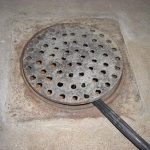If you have a small kitchen with limited space, installing a dishwasher alongside your kitchen sink may be a challenge. However, this doesn’t mean you have to forego the convenience of a dishwasher altogether. With the right knowledge and tools, you can learn how to plumb a dishwasher without a sink and make your dishwashing routine much easier.
To plumb a dishwasher without a sink, you’ll need a dishwasher island and proper connections for draining and water lines. It’s important to consider factors like sink drain distance, electricity options, ventilation, and supply lines to ensure your dishwasher operates smoothly.
In this article, we’ll guide you how to plumb dishwasher drain without sink, so you can enjoy the benefits of a dishwasher even in a small kitchen.
Step-by-step guide for Plumbing a Dishwasher Drain Without Sink
Step 1: Tool Requirements
To install a dishwasher drain without a sink, you will need a few essential items. These include the following:
- P-trap
- Braided supply hose
- Tee branch
- Air gap
- Plumbing tape
- Screwdriver
- Allen wrench
Step 2: Connect the P trap
To connect the P trap to the dishwasher, attach the longer tailpiece of the dishwasher to the P trap. Secure the connection with slip nuts using a screwdriver. Make sure to select the right-sized P trap based on your dishwasher drain size. Once you have the right P trap, connect it to the longer tailpiece. Use Teflon or plumbing tape to cover the connection point, and use a rubber washer between the P trap and tailpiece to make the system watertight. Plumbing tape will also extend the lifespan of the connection and prevent mould and residue growth around the connecting point.
Step 3: Plumbing the P trap with the tee branch
The dishwasher tee is located under the dishwasher, allowing it to extend the drain attachment to connect with the main drainage system of your home. After connecting it to the dishwasher, connect it to the other side of the P trap. Connect the drain hose of the dishwasher with the inlet of the air gap before draining it finally. The inlet of the air gap is usually the larger side.
Step 4: Plumbing with the main drain
Connect the main draining line to the dishwasher by running the drain hose through the air gap or high loop attached to it first. Once it goes through the loop or air gap, it comes back to connect with the draining line. Since there will be no sink with the dishwasher, you will not have a garbage disposal. Use a branch fitting to connect the dishwasher tailpiece to the drain line. To secure the connection, use a metal clamp and plumbing tape.
Step 5: Lay the water supply line
Connect the dishwasher to the water supply line using the hot water line. Connect the braided steel water supply hose with the inlet valve of your dishwasher. Make sure it can accommodate the hot water supply without any damage. Connect its other end with the nearest hot water supply shut-off valve. To get the right-sized dishwasher hot water line hose, measure the distance between the dishwasher and the hot water supply line. You will also need a 90-degree elbow to hook the supply hose to the dishwasher, known as a brass fitting. Ensure that you get a good-quality brass fitting to prevent rust and corrosion.
Step 6: Check the electrical and venting system
The dishwasher’s performance depends on the proper electrical line and venting system. Attach the electrical wiring and venting system if you are confident enough. However, we recommend calling a professional to fix the electrical wiring and venting system for the dishwasher to avoid any potential harm. A wrongly mounted dishwasher electrical system may cause disaster to your plumbing system and even hurt you. Do not compromise the plumbing system and the electrical wiring of your dishwasher.
3 Things to Consider When Installing The Dishwasher Drain Without A Sink
Check the Supply Lines Carefully:
When installing a dishwasher without a sink, you will need to run separate supply lines to connect the dishwasher with the readily available cold water supply line.
Access underneath the cabinet is necessary to connect the island dishwasher supply line plumbing.
It is important to check the supply lines carefully to ensure that the connection is made properly.
Determine the Drain Distance:
You also need to measure the distance between the dishwasher and the drain pipe system. It is possible to connect an island dishwasher with the sink drain at a distance.
However, when you choose the drain pipe and its length, know that the dishwasher ejects the water forcefully after use.
So, you will need a lengthier hose than the actual distance of the dishwasher to the draining point to handle this forced pressure. Measuring the distance accurately will help you choose the right drain and water supply pipes length.
Consider the Electricity System and Ventilation:
The electrical outlet of your dishwasher should be rated at 20 Amps to handle the required electricity of the dishwasher. It is important to connect the electrical wiring with the dedicated outlet with GFEC grounding for safety.
Additionally, you must vent the drain pipe so that the water flows through the hose with proper pressure. It helps the used water to drain smoothly.
You will need an additional island loop vent with the island dishwasher and without the sink. It loops under the dishwasher countertop and supplies maximum air to the draining pipe.
It is important to keep in mind that installing a dishwasher without a sink can be a complex process.
It is recommended to consult a professional plumber to ensure that the installation complies with building codes and is done safely. Proper installation will help prevent leaks and ensure that the dishwasher is level. Use wire nuts and wiring connections for connecting the white wire to the circuit breaker.
By considering these factors, you can install a standard-size dishwasher without a sink with ease.
FAQs
Can You Hook Up a Dishwasher Without a Sink?
Yes, you can install a dishwasher without a sink. However, you will need to install additional water supply and drainage lines. It is recommended that you hire a professional to ensure proper electrical outlet and ventilation installation.
Can the Dishwasher Drain Directly into the Waste Line?
While building codes do not prohibit you from connecting your dishwasher directly to the waste line, it is not recommended. Doing so can cause the waste line to become clogged with food residues.
Can a Dishwasher Run Without a Sink?
Yes, you can run a dishwasher without a sink. Follow the instructions for plumbing the dishwasher without a sink.
Conclusion
By following the minimum plumbing skills, you can easily plumb a dishwasher without a sink. However, it is advisable to call a professional plumber for the venting system to ensure smooth water flow. Improper venting or electrical outlet installation can be accidental, which can be dangerous.




